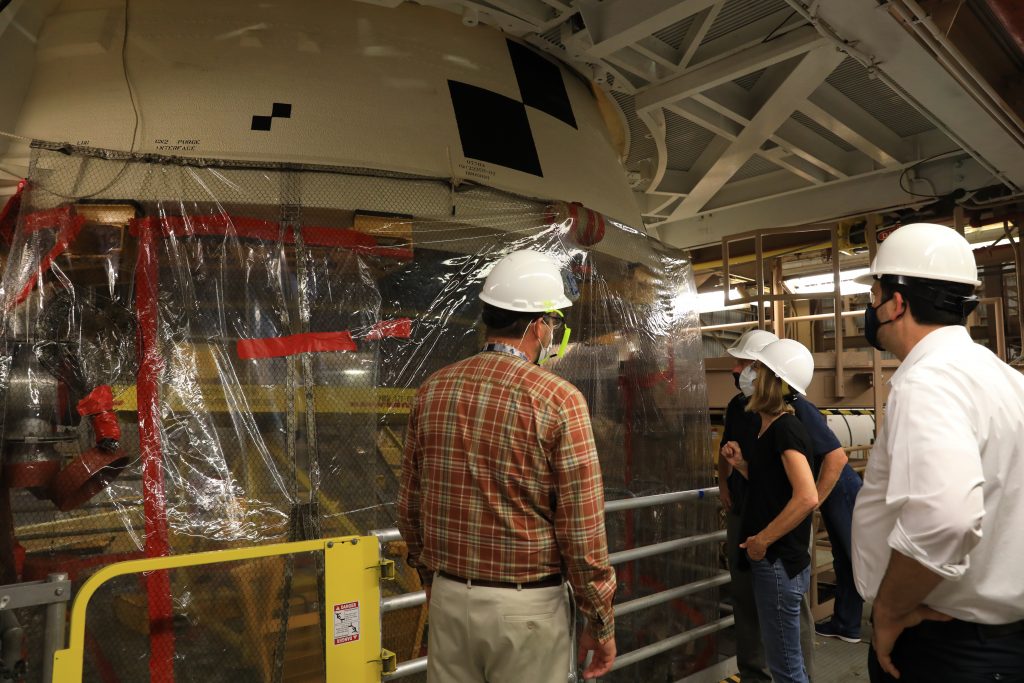Jumping headfirst into the Artemis program has been one of the highlights in my transition as the associate administrator for human spaceflight. With an ongoing COVID-19 pandemic, there was little time for a transition period as mission essential work needed to continue as safely as possible.
Already within my short time on the job, NASA is checking-off key milestones and marching swiftly toward Artemis I. That mission, the first uncrewed flight test of our powerful Space Launch System (SLS) rocket and Orion spacecraft, is just a little more than a year away from launch.
I remain incredibly impressed by our team’s commitment to landing the first woman and next man on the Moon in 2024, and we all know that Artemis I is a critical step toward realizing that goal. A lot of the hard work is behind us, but it is not done yet. We’re gaining momentum– and it is tangible across the agency.
Already this year, NASA has finished modifications and upgrades to ready Launch Pad 39B at our Kennedy Space Center in Florida for the mission. Teams there have also:
- Simulated portions of the launch countdown with a realistic run-through of the terminal count
- Delivered the launch vehicle stage adapter, which connects the core stage and the upper stage of the rocket
- Conducted an Orion recovery test in the Pacific Ocean, validating timelines for recovery operations
- Practiced stacking operations with pathfinder segments for the solid rocket boosters
- Received booster segments for the mission to begin processing for launch
The agency also completed a rigorous test campaign ahead of schedule on the Orion spacecraft, subjecting it to the extreme temperatures and electromagnetic conditions expected during flight. Orion is now in final assembly and checkout for launch, including installation of the spacecraft’s four solar arrays.
On the SLS side of the house, NASA completed structural testing on the upper part of the rocket and four core stages structures. The rocket’s core stage for the first mission is the last piece of hardware that remains to be delivered to Kennedy. It is currently secured in a test stand at NASA’s Stennis Space Center in Mississippi and has completed four of the eight tests in the Green Run test series.
We are currently working our way through the fifth test to check out the thrust vector controls and related hydraulics. While we keep an eye on hurricane season, we continue to strive to conduct the final test by the end of October with the current pace of testing. During that test, engineers will fire all four RS-25 engines simultaneously, aiming to drain the fueled tanks in eight minutes, just as during flight. After the hot fire test, crews will refurbish, inspect, and configure the stage for shipment to Kennedy. The next time the rocket’s engines ignite, Artemis I will be taking flight.
Prior to the COVID-19 pandemic, NASA also completed a detailed cost and schedule assessment for Artemis I and established a new agency commitment for launch readiness by November 2021. While it is too early to predict the full impact of COVID-19, we are confident a November 2021 date is achievable with the recent pace of progress, and a successful Green Run hot fire test will enable us to better predict a target launch date for the mission.
Taking this new launch readiness date into account, NASA also aligned the development costs for the SLS and Exploration Ground Systems programs through Artemis I and established new cost commitments. The new development baseline cost for SLS is $9.1 billion, and the commitment for the initial ground systems capability to support the mission is now $2.4 billion. NASA’s cost and schedule commitment for Orion currently remains within original targets and is tied to demonstrating the capability to fly crew on the Artemis II mission by 2023.
NASA has notified Congress of these new commitments, and we are working at the best possible pace toward launch, including streamlining operational flow at Kennedy and assessing opportunities to further improve the efficiency of our integration activities. Now that the majority of the design development is done, as well as the first time build and an extensive test program, a lot of effort is behind us. We are well into builds for future missions, and we are seeing significantly improved build rates, high quality work, and efficiencies across the board. Moving forward, we aim to continue to reduce production costs for the world’s most capable launch system, as we take on new challenges of our lunar exploration program.
We remain focused on the work ahead under the Artemis program, for the first SLS and Orion mission as well as future missions with crew, including Artemis III that will send the next astronauts to the surface of the Moon. With those kind of goals, there’s nowhere else in the world I’d rather be working. And yet, Artemis plans are just one of many great things underway within human spaceflight and across the agency – with much more ahead.
NASA is on track to achieve great things with robots, technology and humans on and around the Moon. From the Moon, and soon to Mars, I hope you’re ready to jump in too.
-Kathy Lueders

